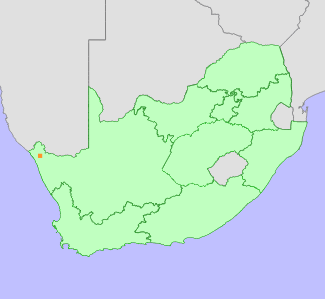|
Scientific Name | Conophytum bolusiae Schwantes subsp. primavernum S.A.Hammer |
Higher Classification | Dicotyledons |
Family | AIZOACEAE |
National Status |
Status and Criteria | Critically Endangered A3d; B1ab(iii) |
Assessment Date | 2021/11/15 |
Assessor(s) | A.J. Young, P.G. Desmet, I. Ebrahim, D. Guo, A. Harrower, L. Jabar, L. Knoetze, C. Rodgerson, P.C.V. Van Wyk & N.N. Mhlongo |
Justification | This succulent is endemic to the Northern Cape province of South Africa where it is only recorded from a single location with an extent of occurrence (EOO) and area of occupancy (AOO) of 12 km². There is ongoing decline in habitat quality inferred from loss of vegetation cover. Furthermore the dwarf succulents that comprise this genus have been increasingly targeted by illegal collection in recent years and the vast majority of species are in high demand by collectors. Whilst there is no evidence of illegal collection at the time of this submission, closely related species, including many from the immediate area, have been illegally removed from habitat with a dramatic increase in the number of species and volume of plants targeted since 2019. The threat of illegal collection is therefore regarded as very high for this particular taxon given its single location. Climate change is also impacting the population although there is uncertainty of the response given the expected resilience of this taxon. A decline of over 90% of the population is suspected within a single generation (30 years). It therefore qualifies as Critically Endangered under criteria A3 and B1. |
Distribution |
Endemism | South African endemic |
Provincial distribution | Northern Cape |
Range | This dwarf succulent is endemic to a small part of the Northern Cape province of South Africa where it is only found in a single location with a restricted geographic range. |
Habitat and Ecology |
Major system | Terrestrial |
Major habitats | Lekkersing Succulent Shrubland |
Description | This taxon is endemic to the Richtersveld bioregion of the Succulent Karoo biome where it is found on several contiguous quartzite hills. It inhabits sheltered valleys, often occupying vertical fissures in quartz rocks and ridges. The plants experience sporadic winter rainfall but frequent exposure to fog is regarded as a critical source of moisture. This taxon has a generation length of 30 years. It is expected to be sensitive to the impacts of climate change as it does not disperse and while adapted to arid conditions, is dependent on limited seasonal rainfall. Species in the genus are sensitive to long periods of drought. Drought related mortality has been observed for other closely related taxa within the genus. |
Threats |
| This subspecies has a very small legal trade in cultivated plants and there are no reports of illegal collection of plants from habitat. However, an extensive illegal trade for the ornamental succulent market in habitat-collected plants in this region of other species within this genus including closely related taxa has developed since 2019. The plants are severely range-restricted which renders them highly susceptible to a rapid decline in number through collection. The single location is close to human habitation. This particular species is therefore considered to be at high risk of illegal collection.
Anthropogenic climate change is a long-term threat to this succulent. While it is not possible to model the response of this subspecies to climate change due to its restricted distribution, the average loss to climate change for 21 more widely distributed Conophytum species occurring within the same region is used as an indication of likely impact to this species. Climate models for the likely emission scenarios where emissions stay at present day levels (RCP 2.6) (Hausfather and Peters 2020) and worst case scenarios where emissions continue to increase during the 21st century (RCP 8.5) indicate that there will be a loss of suitable bioclimatic envelope of between 56% and 86% by 2080 for Conophytum taxa within the region. However, as this taxon occurs in a very sheltered habitat it is expected to have a level of resilience to climate change and the expected population loss is reduced by 20% to 36%. Species in this genus have limited dispersal ability and migration to suitable habitats elsewhere is regarded as highly unlikely. Climate change is already negatively impacting this taxon as there has been a loss of vegetation cover determined from changes in Enhanced Vegetation Index (EVI) between 1984 and 2018 using Landsat data (Venter et al. 2020). |
Population |
This taxon is locally very abundant. The population size is estimated to be several thousand plants. There is no evidence yet of population decline. This particular subspecies is not currently threatened by illegal collection but it is likely that it will become a target in coming years as the majority of other species in the genus have been targeted in recent years including some from the immediate vicinity.
|
Population trend | Unknown |
Assessment History |
Taxon assessed |
Status and Criteria |
Citation/Red List version | | Conophytum bolusiae Schwantes subsp. primavernum S.A.Hammer | VU D2 | 2017.1 | | Conophytum bolusiae Schwantes subsp. primavernum S.A.Hammer | Rare | 2015.1 | | Conophytum bolusiae Schwantes subsp. primavernum S.A.Hammer | Least Concern | Raimondo et al. (2009) | |
Bibliography |
Hammer, S. 2002. Dumpling and his wife: New view of the genus Conophytum. EAE Creative Colour, Norwich.
Hammer, S.A. 1993. The genus Conophytum: A conograph. Succulent Plant Publications, Pretoria.
Hausfather, Z. and Peters, G.P. 2020. Emissions - the 'business as usual' story is misleading. Nature 577(618-620).
|
Citation |
| Young, A.J., Desmet, P.G., Ebrahim, I., Guo, D., Harrower, A., Jabar, L., Knoetze, L., Rodgerson, C., Van Wyk, P.C.V. & Mhlongo, N.N. 2021. Conophytum bolusiae Schwantes subsp. primavernum S.A.Hammer. National Assessment: Red List of South African Plants version 2024.1. Accessed on 2025/10/27 |
 Comment on this assessment
Comment on this assessment


